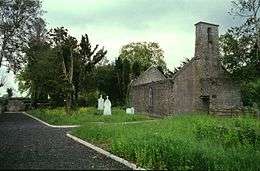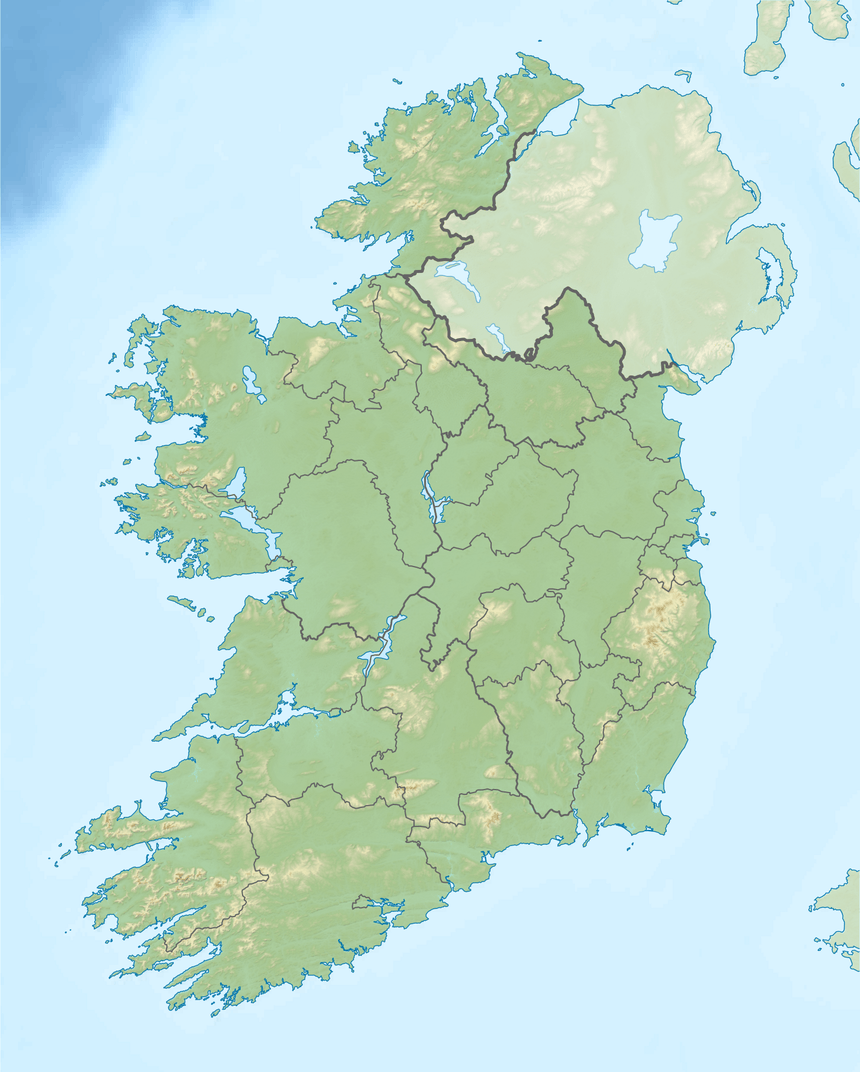Mansfieldstown Church
St. Mary's Church, Mansfieldstown is a medieval church and National Monument in County Louth, Ireland.[1][2]
| St. Mary's Church | |||||||||
|---|---|---|---|---|---|---|---|---|---|
| Mansfieldstown Church | |||||||||
Eaglais Mhuire | |||||||||
 | |||||||||
 St. Mary's Church | |||||||||
| 53.896892°N 6.445712°W | |||||||||
| Location | Mansfieldstown, Castlebellingham, County Louth | ||||||||
| Country | Ireland | ||||||||
| Denomination | Church of Ireland | ||||||||
| History | |||||||||
| Dedication | Mary, mother of Jesus | ||||||||
| Architecture | |||||||||
| Functional status | inactive | ||||||||
| Style | Late Gothic | ||||||||
| Completed | 1691 | ||||||||
| Specifications | |||||||||
| Materials | rubble | ||||||||
| Administration | |||||||||
| Diocese | Armagh | ||||||||
| |||||||||
Location
Mansfieldstown Church is located 3.7 km (2.3 mi) west of Castlebellingham, on the north bank of the River Glyde.[3]
History
The townland name is derived from the Anglo-Norman Maundeville family who settled here after 1172. The earliest reference to a church here is in the Papal Registers of 1299. Archbishop Richard FitzRalph delivered a sermon at Mansfieldstown in 1349, in the midst of the Black Death. The church was recorded as ruined in 1640.[4][5]
Mansfieldstown Old Church was built in 1691, after the Battle of the Boyne, but incorporates a 15th-century Late Gothic east window. There were many alterations and additions made in the 19th century.[6][7] A large, decorated, c. 15th-century baptismal font once stood here; it is now in St. Mary's Parish Church, Ardee.[8][9]
Anthony Vinchon Des Voeux (1710–92) was rector at Mansfieldstown from 1781 to his death in 1792. He was born in France, son of the President of the Parlement de Normandie, and wrote in defence of the Huguenot faith. He was chaplain to George Germain, 1st Viscount Sackville's 6th Regiment. His son Charles became a baronet in 1787, the first of the Des Voeux baronets.[10]
Church
Mansfieldstown Church is an undivided nave and chancel with a bell-cote at the west end. The Late Gothic east window has tracery. It has two stone masks as label-stops with a third mask at the apex.[11]
References
- ""Knock down the Established Church"-speech of Alderman Dillon at the first meeting of the National Association, etc. [A reply to the speech. With a prefatory note signed: J. H. B.]". Hodges, Smith & Company. 1 January 1865 – via Google Books.
- MORRISON, William Robert (1 January 1868). "Mr. Gladstone's statements examined; the Report of the Royal Commission on the Irish Church, and the question of Disestablishment and Disendowment considered ... Third ... edition ... enlarged". J. Heywood – via Google Books.
- Smith, Brendan (20 June 2013). "Crisis and Survival in Late Medieval Ireland: The English of Louth and Their Neighbours, 1330-1450". OUP Oxford – via Google Books.
- "Louth County Council Development Plan 2003" (PDF). Louthcoco.ie. Retrieved 2 January 2019.
- Smith, Brendan (20 June 2013). "Crisis and Survival in Late Medieval Ireland: The English of Louth and Their Neighbours, 1330-1450". OUP Oxford – via Google Books.
- "St Marys Church, Mansfieldstown , County Louth (1691)". Flickr.com.
- "Patron day in historic Mansfieldstown cemetery". Independent.ie.
- "Geograph:: Mansfieldtown Church, Co. Louth (C) Kieran Campbell". Geograph.ie.
- "Archived copy". Archived from the original on 2016-08-14. Retrieved 2016-09-19.CS1 maint: archived copy as title (link)
- "Full text of "History of Kilsaran union of parishes in the County of Louth, being a history of the parishes of Kilsaran, Gernonstown, Stabannon, Manfieldstown, and Dromiskin, with many particulars relating to the parishes of Richardstown, Dromin, and Darver, comprising a large section of mid-Louth"" (TXT). Archive.org. Retrieved 2 January 2019.
- "MansfieldstownChurch". Irishantiquities.bravehost.com.